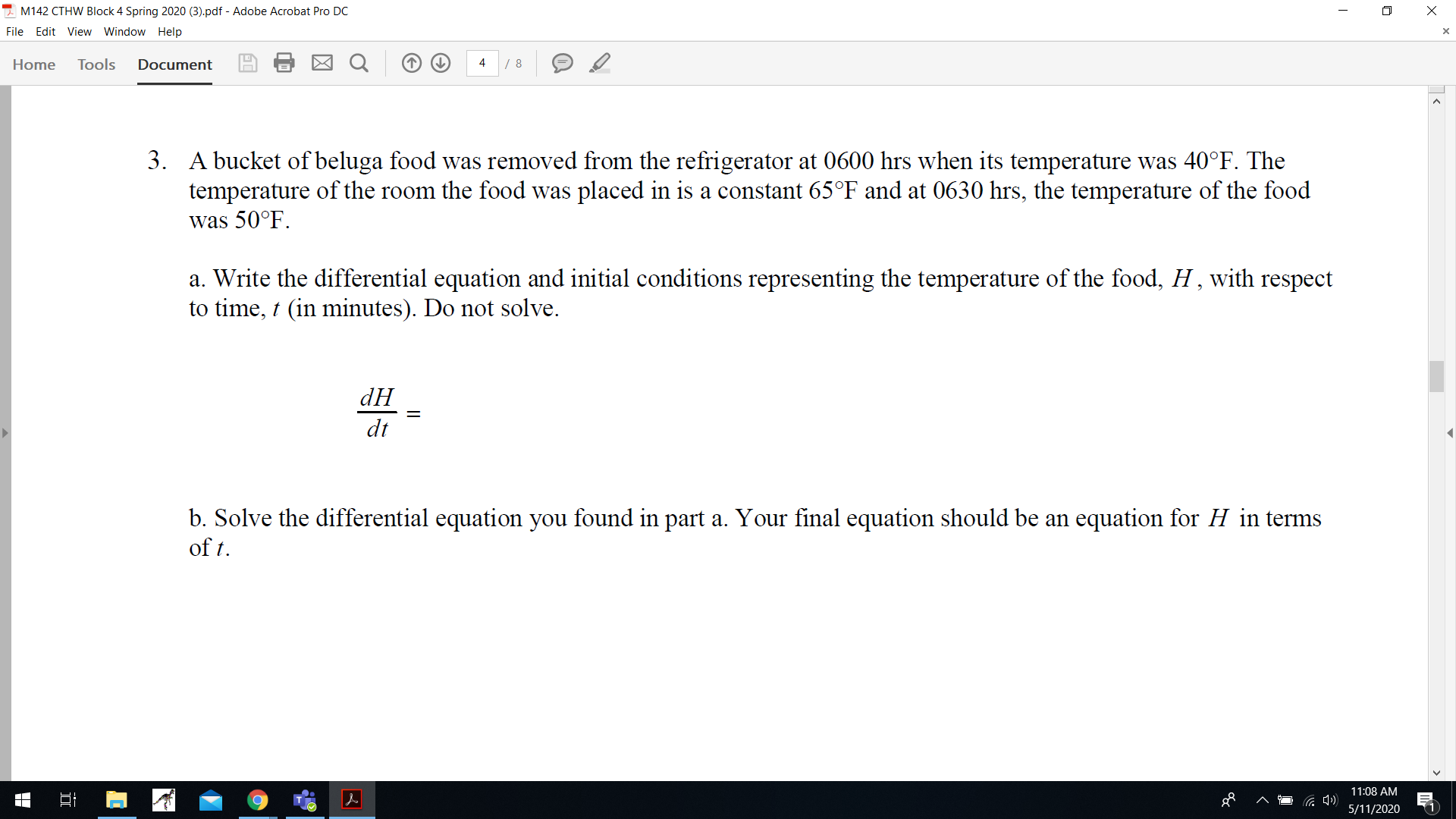
Calculus: Early Transcendentals
8th Edition
ISBN: 9781285741550
Author: James Stewart
Publisher: Cengage Learning
expand_more
expand_more
format_list_bulleted
Concept explainers
Question

Transcribed Image Text:A bucket of beluga food was removed from the refrigerator at 0600 hrs when its temperature was 40°F. The
temperature of the room the food was placed in is a constant 65°F and at 0630 hrs, the temperature of the food
was 50°F.
a. Write the differential equation and initial conditions representing the temperature of the food, H, with respect
to time, 1 (in minutes). Do not solve.
dt
b. Solve the differential equation you found in part a. Your final equation should be an equation for H in terms
Expert Solution
This question has been solved!
Explore an expertly crafted, step-by-step solution for a thorough understanding of key concepts.
This is a popular solution
Trending nowThis is a popular solution!
Step by stepSolved in 3 steps with 3 images

Knowledge Booster
Learn more about
Need a deep-dive on the concept behind this application? Look no further. Learn more about this topic, calculus and related others by exploring similar questions and additional content below.Similar questions
- solve the differential equation and state whether the corresponding motion is underdamped, overdamped, or critically damped.arrow_forwardIn a nursery, the reason for spreading a virus epidemic is equal to half of those who have not gotten sick yet. if 200 children are enrolled in the nursery, give a differential equation for the number of children infected N with respect to time t in days. Solve the differential equation to answer the following: If a sick child started the epidemic, will they all be infected three days later?arrow_forwardA thermometer reading 96o is placed inside a cold storage room with a constant temperature of 37o If the thermometer reads 88o in 5 minutes, how long before it reaches 53o Assume the cooling follows Newton's Law of Cooling: U = T + (Uo - T)ekt.arrow_forward
- dw To determine how fast a change in weight will occur, the most plausible assumption is that is proportional to the net excess (or deficit) C - 19.25w in the number of calories per day. Answer parts a. through e. dt below. a. Assume C is constant and write a differential equation to express this relationship. Use k to represent the constant of proportionality. dw dtarrow_forwardWater flows into a tank, and a certain part of it drains out through a valve. The volume v (in cubic feet) of water in the tank at time t satisfies the equation dv/dt = 5 − (v/3). If the process continues for a long time, how much water will be in the tank?a. 13 cubic feetb. 14 cubic feetc. 15 cubic feetd. 16 cubic feetarrow_forward
arrow_back_ios
arrow_forward_ios
Recommended textbooks for you
 Calculus: Early TranscendentalsCalculusISBN:9781285741550Author:James StewartPublisher:Cengage Learning
Calculus: Early TranscendentalsCalculusISBN:9781285741550Author:James StewartPublisher:Cengage Learning Thomas' Calculus (14th Edition)CalculusISBN:9780134438986Author:Joel R. Hass, Christopher E. Heil, Maurice D. WeirPublisher:PEARSON
Thomas' Calculus (14th Edition)CalculusISBN:9780134438986Author:Joel R. Hass, Christopher E. Heil, Maurice D. WeirPublisher:PEARSON Calculus: Early Transcendentals (3rd Edition)CalculusISBN:9780134763644Author:William L. Briggs, Lyle Cochran, Bernard Gillett, Eric SchulzPublisher:PEARSON
Calculus: Early Transcendentals (3rd Edition)CalculusISBN:9780134763644Author:William L. Briggs, Lyle Cochran, Bernard Gillett, Eric SchulzPublisher:PEARSON Calculus: Early TranscendentalsCalculusISBN:9781319050740Author:Jon Rogawski, Colin Adams, Robert FranzosaPublisher:W. H. Freeman
Calculus: Early TranscendentalsCalculusISBN:9781319050740Author:Jon Rogawski, Colin Adams, Robert FranzosaPublisher:W. H. Freeman
 Calculus: Early Transcendental FunctionsCalculusISBN:9781337552516Author:Ron Larson, Bruce H. EdwardsPublisher:Cengage Learning
Calculus: Early Transcendental FunctionsCalculusISBN:9781337552516Author:Ron Larson, Bruce H. EdwardsPublisher:Cengage Learning

Calculus: Early Transcendentals
Calculus
ISBN:9781285741550
Author:James Stewart
Publisher:Cengage Learning

Thomas' Calculus (14th Edition)
Calculus
ISBN:9780134438986
Author:Joel R. Hass, Christopher E. Heil, Maurice D. Weir
Publisher:PEARSON

Calculus: Early Transcendentals (3rd Edition)
Calculus
ISBN:9780134763644
Author:William L. Briggs, Lyle Cochran, Bernard Gillett, Eric Schulz
Publisher:PEARSON

Calculus: Early Transcendentals
Calculus
ISBN:9781319050740
Author:Jon Rogawski, Colin Adams, Robert Franzosa
Publisher:W. H. Freeman


Calculus: Early Transcendental Functions
Calculus
ISBN:9781337552516
Author:Ron Larson, Bruce H. Edwards
Publisher:Cengage Learning